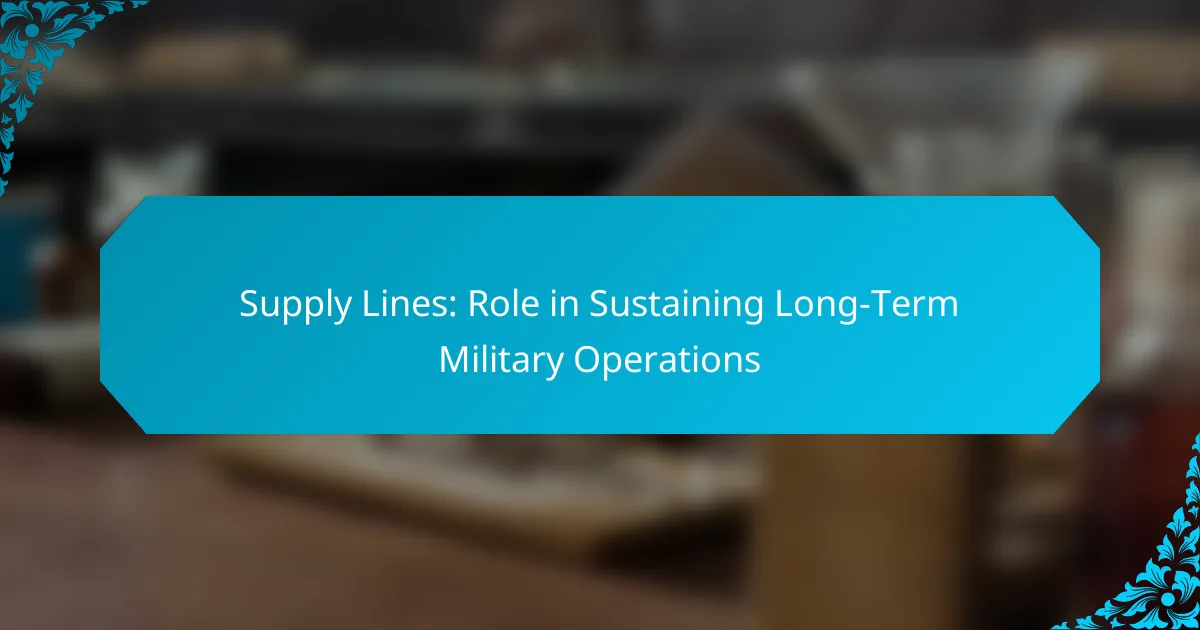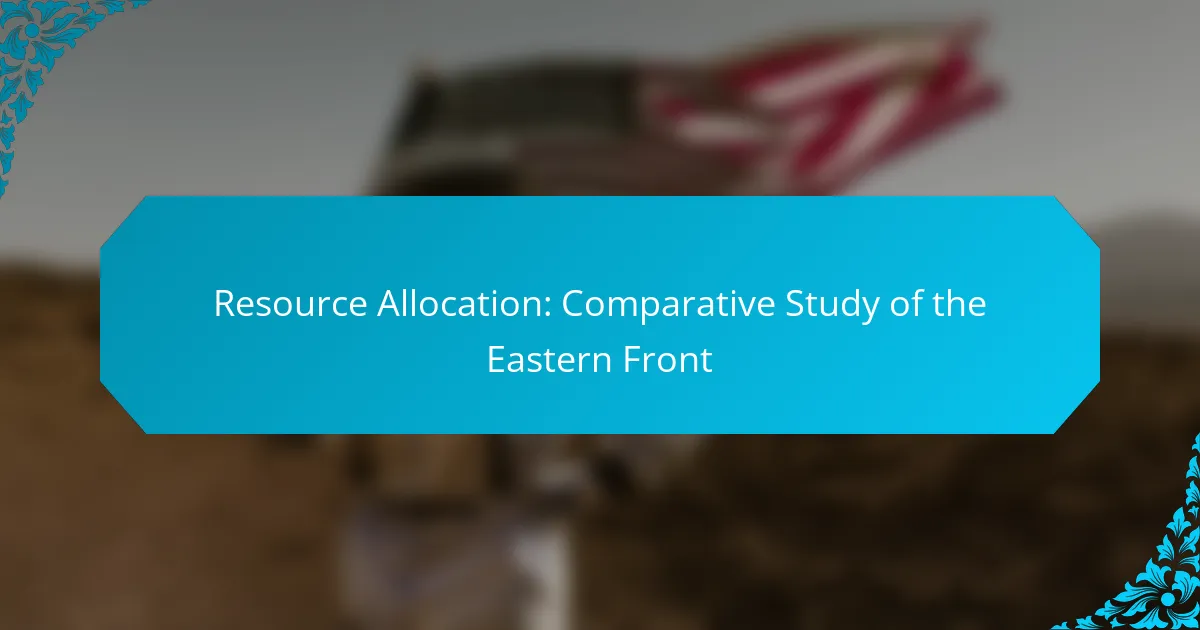Supply lines are essential for the success of long-term military operations, as they ensure that troops receive the necessary resources to maintain effectiveness and readiness. These lines encompass a complex network of transportation, warehousing, and communication systems that work in unison to deliver personnel and materials. However, they also face numerous challenges, including vulnerabilities to enemy actions and logistical disruptions, which can significantly affect operational success.

How Do Supply Lines Support Military Operations?
Supply lines are critical for sustaining military operations by ensuring that troops receive the necessary resources to function effectively. They facilitate the movement of personnel and materials, enabling forces to maintain operational readiness over extended periods.
Logistical support for troop movements
Logistical support is essential for the timely and efficient movement of troops to various operational areas. This includes planning routes, managing transportation assets, and coordinating with different military branches to ensure that forces are deployed where they are most needed.
Effective logistical planning can minimize delays and enhance troop mobility. For instance, using a combination of air, land, and sea transport can optimize the deployment of units, especially in complex terrains or hostile environments.
Provision of essential supplies
Essential supplies include food, water, ammunition, and medical supplies, all of which are vital for sustaining military personnel. Supply lines must be robust enough to deliver these items consistently, particularly in remote or combat zones.
Establishing supply depots close to the front lines can reduce delivery times and ensure that troops have immediate access to what they need. Regular assessments of supply levels and consumption rates help maintain adequate stockpiles and avoid shortages.
Maintenance of equipment and vehicles
Maintaining equipment and vehicles is crucial for operational effectiveness. Supply lines must include provisions for spare parts, tools, and maintenance personnel to keep military assets in working order.
Implementing a preventive maintenance schedule can help identify potential issues before they become critical. Additionally, mobile repair units can be deployed alongside troops to provide immediate support, reducing downtime and enhancing combat readiness.
Coordination of transportation routes
Coordinating transportation routes is vital for ensuring that supplies reach their destinations efficiently and safely. This involves mapping out the best paths, considering factors such as terrain, enemy activity, and weather conditions.
Using technology, such as GPS and real-time tracking systems, can enhance route planning and execution. Regularly updating transportation plans based on current intelligence helps mitigate risks and ensures that supply lines remain secure and effective.

What Are the Key Components of Military Supply Lines?
Military supply lines consist of essential elements that ensure the effective delivery of resources, equipment, and personnel during operations. Key components include transportation networks, warehousing and distribution centers, and communication systems, all of which work together to maintain operational readiness and efficiency.
Transportation networks
Transportation networks are vital for moving supplies from production sites to the front lines. These networks can include roads, railways, air routes, and waterways, each with its own advantages and limitations. For instance, air transport is fast but costly, while railways can handle larger quantities but may be slower.
When planning transportation, consider factors such as distance, terrain, and available infrastructure. Efficient routing and scheduling are crucial to minimize delays and ensure timely delivery of essential materials. Regular assessments of transportation capabilities can help identify potential bottlenecks.
Warehousing and distribution centers
Warehousing and distribution centers serve as critical hubs for storing and managing supplies before they reach operational units. These facilities must be strategically located to optimize access to transportation networks and minimize transit times. Effective inventory management practices are essential to ensure that the right supplies are available when needed.
Consider implementing automated systems for tracking inventory levels and managing stock rotation. This can help prevent shortages and reduce waste. Additionally, establishing contingency plans for rapid distribution can enhance responsiveness during emergencies.
Communication systems
Communication systems are essential for coordinating supply line operations and ensuring that all units are informed about logistics status. These systems can include radio, satellite, and internet-based communication tools, which facilitate real-time updates and decision-making. Reliable communication helps prevent misunderstandings and delays in supply delivery.
Investing in robust communication infrastructure is crucial, especially in remote or hostile environments. Regular training for personnel on using these systems can improve operational efficiency. Additionally, establishing clear protocols for reporting supply needs can enhance responsiveness and resource allocation.

What Challenges Do Military Supply Lines Face?
Military supply lines encounter several significant challenges that can hinder effective operations. These challenges include vulnerability to enemy attacks, logistical bottlenecks, and supply chain disruptions, all of which can impact mission success and troop readiness.
Vulnerability to enemy attacks
Military supply lines are often prime targets for enemy forces, making them vulnerable to attacks. Disrupting these lines can severely limit the availability of essential resources such as food, ammunition, and medical supplies.
To mitigate this risk, military planners must implement strategies such as route diversification, increased security measures, and the use of technology for real-time monitoring. For example, employing drones for reconnaissance can help identify potential threats along supply routes.
Logistical bottlenecks
Logistical bottlenecks occur when the flow of supplies is impeded, often due to inadequate infrastructure or overwhelming demand. These bottlenecks can lead to delays in delivering critical materials to frontline units.
To address this issue, military operations should prioritize efficient routing and scheduling, utilizing advanced logistics software to optimize supply chain management. Regular assessments of infrastructure and transportation capabilities can also help identify and alleviate potential bottlenecks before they escalate.
Supply chain disruptions
Supply chain disruptions can arise from various factors, including natural disasters, political instability, or unexpected demand spikes. Such disruptions can jeopardize the timely availability of necessary supplies for military operations.
To minimize the impact of these disruptions, military organizations should establish contingency plans that include alternative suppliers and stockpiling critical resources. Regular training exercises can also prepare personnel to respond effectively to unforeseen supply chain challenges.

How Can Technology Improve Supply Line Efficiency?
Technology can significantly enhance supply line efficiency by streamlining processes, reducing delays, and improving accuracy in logistics. Implementing advanced tools such as drones, real-time tracking systems, and automated inventory management can lead to faster and more reliable military operations.
Use of drones for delivery
Drones can facilitate rapid delivery of supplies to remote or frontline locations, overcoming obstacles like difficult terrain or enemy activity. They can transport medical supplies, ammunition, and food, ensuring that troops receive essential resources without delay.
When deploying drones, consider the payload capacity and range. Most military drones can carry between a few kilograms to several hundred kilograms, with ranges varying from a few kilometers to over a hundred kilometers, depending on the model.
Real-time tracking systems
Real-time tracking systems allow military units to monitor the status and location of supplies throughout the supply chain. This technology enhances visibility, enabling commanders to make informed decisions and adjust logistics as needed to prevent shortages or delays.
Implementing GPS and RFID technologies can improve tracking accuracy. These systems can provide updates in low tens of milliseconds, ensuring that all personnel have access to the latest information about supply movements.
Automated inventory management
Automated inventory management systems streamline the process of tracking supplies, reducing human error and ensuring that stock levels are accurately maintained. These systems can automatically reorder supplies when levels fall below a predetermined threshold, preventing shortages.
Utilizing barcodes or QR codes can enhance inventory accuracy. Regular audits and updates to the inventory system are essential to maintain data integrity and ensure that the supplies are always available when needed.

What Are the Best Practices for Managing Supply Lines?
Effective management of supply lines is crucial for sustaining long-term military operations. Best practices include regular assessments, strategic planning, and leveraging technology to ensure timely delivery of resources.
Regular assessments of supply routes
Regular assessments of supply routes help identify potential vulnerabilities and inefficiencies. This involves analyzing current routes for factors such as terrain, weather conditions, and enemy activity, which can impact the reliability of supply delivery.
Military planners should conduct these assessments frequently, especially before and during operations. Utilizing tools like Geographic Information Systems (GIS) can enhance route analysis by providing real-time data on conditions and threats.
Establishing a checklist for route assessments can streamline the process. Key elements to consider include accessibility, security measures, and alternative routes to ensure flexibility in logistics planning.



